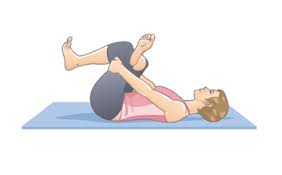One of the poses that is getting a lot more scrutiny among teachers focusing on anatomy and biomechanics is Pigeon Pose:

It’s a pose where it’s common to see students completely flop into the shape, giving up on any attention to detail or alignment and instead using it a a way to rest before Shavasana.
The intention of relaxing into the pose is fine but to abandon all sense of creating an actual shape is not. I do now offer the posture after a few months of skipping it entirely but now my cues are quite specific to help students avoid sagging into their joints.
For many people, they will come into this pose and feel discomfort around the knee. The knee was built more to flex and bend and here in this pose, the bent knee is actually moving laterally (side to side) which the joint CAN do, but I like to say “it’s not it’s best work.” You see, when it does move side to side, it can strain the ligaments on the sides of the knee and sometimes that creates a sensation of pain for the student. Also, students sometimes complain of tingling or numbness in the knee or along the leg, above or below the knee ( This can be due to nerve compression which should definitely be checked out by a physician).
I had a student complain of this in class the other day and I immediately had her move onto her back and do the pose in a “figure four” arrangement:

When we flip the pose on the back, it completely changes on our relationship to gravity. Now, instead of working against gravity, we’re working WITH it. It’s the same reason I like to start class on the back sometimes. You can read about that here.
The other issue to keep in mind is that when we take Pigeon in the traditional way, there is a quite a significant amount of pressure we put on the knee, especially if we first set the bent knee down, move the shin forward and THEN lengthen the other leg back. In this movement, we’re leveraging our entire body weight on that knee. I always encourage my students to avoid using the bent knee as the touch base off of which the pose is built and instead come down to the elbows and forearms as well as the knee and the extended leg and then from there, work your way into position.
One thing to keep in mind, as with any pose but this one variation is particular, is that it does have a shape. You’re basically doing the same thing as in the face down version but you’re on your back. That doesn’t mean you should cram your hands in a clasped position around your bent knee, or flop your legs in the air with no intention around the shape of the pose. These poses towards the end of your practice are a chance to bring your whole body back to baseline but many students approach them as a chance to sort of check out and flop into them.
You’ll notice in the shape above, the feet are flexed and the legs create that right angle position. The foot facing forward is the same level as the knee and the neck has its natural curve (lordotic) versus the chin being thrust forward. Sometimes this position will create a bit of extension in the neck. If that is the case, place a rolled up towel under the head to find the natural curve.
This pose is a great way to end practice but it does need to have a shape to it and the alignment is specific. If you do find that you feel pain, tingling or discomfort in your bent knee, take the pose on the back (and also see your doctor!).
If you like anatomically based themes, you may want to check out my free anatomy downloads. There are 3 PDF’s that cover different aspects of anatomy in yoga. You can download them here:
Interested in receiving a 3-PDF Teacher’s Yoga Anatomy Kit? Click here!
